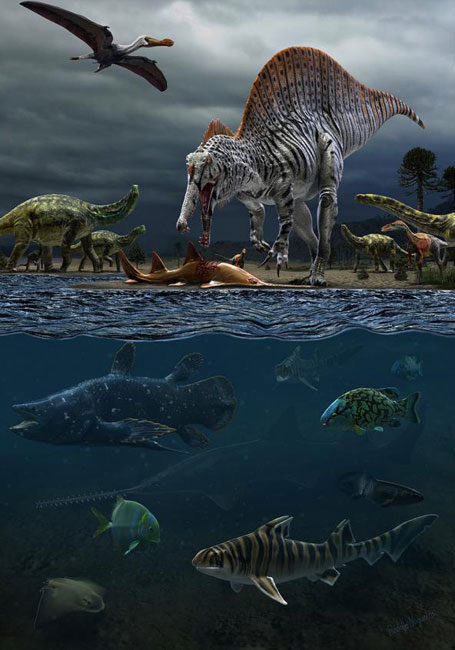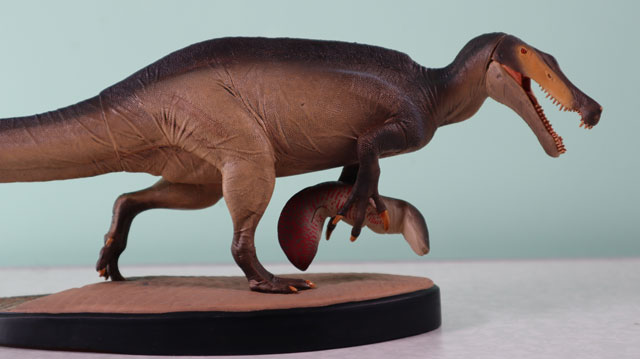Whilst researching the background to a dinosaur model based on fossils found in Brazil (Irritator challengeri), team members at Everything Dinosaur stumbled upon a superb illustration of the fauna associated with the Alcântara Formation.

Illustrating the Ancient Ecosystem (Cretaceous of Brazil)
The stunning artwork created by Rodolfo Nogueira (above), illustrates the biota associated with the Laje do Coringa bone bed found in early Late Cretaceous (Cenomanian stage) deposits of the Alcântara Formation of north-eastern South America.
Terrestrial element: sauropod titanosaurids (left) and andesaurids (right), whilst a giant spinosaurid feeds on an Atlanticopristis equatorialis (centre). The other, smaller theropods depicted in the scene represent noasaurids. A pterosaur (member of the Anhangueridae), soars overhead.
Marine element: a coelacanth (Mawsonia gigas) swims close to the surface on the left of the picture. Pycnodontiform (middle) Myliobatis sp. (bottom) and on the right of the picture Tribodus sp. (sharks), Lepidotes sp. can be seen whilst a giant sawfish Onchopristis sp. swims in the background.
The Lungfish and Irritator challengeri
The new Dino Hazard Irritator challengeri model comes with a lungfish (genus Equinoxiodus) which can be held in the claws of the theropod. The lungfish is a replica of Equinoxiodus alcantarensis which was named and described in 2011 from fossilised tooth plates found in deposits associated with the Alcântara Formation.

Picture credit: Everything Dinosaur
For dinosaur models and prehistoric animal figures: Dinosaur Figures and Prehistoric Animal Replicas.
Whilst the dating of the Irritator challengeri fossil material has proved to be challenging (no pun intended), most palaeontologists estimate that this spinosaurid roamed north-eastern Brazil around 110 million years ago (Albian faunal stage of the Early Cretaceous). The lungfish model (Equinoxiodus alcantarensis) is known from the geologically younger Alcântara Formation (Cenomanian faunal stage).
If Irritator was a piscivore (fish-eater), it may well have hunted lungfish, but E. alcantarensis might be more than ten million years younger than the theropod.
A Unique Record of Cenomanian Fauna of South America
Examination of fossils found in rocks associated with the Alcântara Formation has provided a unique record of the South American Cenomanian continental flora and fauna. Palaeontologists have been able to piece together the ancient ecosystems that existed in this part of the world during the earliest stage of the Late Cretaceous. This has helped scientists to understand the changes in fauna and flora as Gondwana broke apart and the Atlantic Ocean widened. The fossils of the Laje do Coringa bone bed reveal a diverse vertebrate community that lived in the coastal forested areas of the Northern Maranhão state surrounded by a dominantly dry and arid environment.
The bone bed reveals that vertebrate fauna was more similar to the northern African fauna at the time than it was to the fauna associated with rest of South America. This suggests that land bridges permitting faunal interchanges between Africa and north-eastern Brazil may have persisted until the early Cenomanian (about 100 million years ago).
Whilst no Irritator challengeri fossils are known from the Alcântara Formation, fragmentary evidence, mainly in the form of isolated teeth indicate that spinosaurids were present. Teeth found have been ascribed to the roughly coeval Spinosaurus aegyptiacus which is known from Egypt and Morocco.
Discussing the remarkable terrestrial and marine biotas associated with the Alcântara Formation does permit us an opportunity to post up a super illustration by Rodolfo Nogueira.
Visit the Everything Dinosaur website: Everything Dinosaur.






Leave A Comment